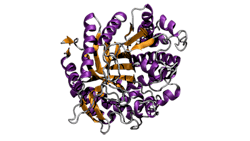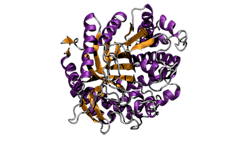Enzyme Promises Faster Bioprocessing
Scientists at Imperial College London say they can break down plant-based biomass 30 times faster than currently possible with a modified glucosidase enzyme (Figure 1). If scaled up, this new technique could reduce fuel-related carbon emissions by 80–100%, they add. It also could lead to cheaper, more environmentally friendly biofuel production and more efficient plastic recycling.
Releasing glucose from cellulose currently is an expensive and time-consuming part of much bioprocessing. This is partly because enzymes typically stop working at temperatures higher than 70°C and when in industrial solvents like ionic liquids instead of water. Furthermore, water’s boiling point of 100°C limits the biocatalyst process, note the researchers.
Figure 1. Scientists at Imperial College London altered the glucosidase enzyme to achieve faster biomass production. Source: Alex Brogan, Imperial College London.
To resolve these issues, Alex Brogan of the college’s dept. of chemical engineering and colleagues altered the chemical structure of glucosidase so it could withstand heat up to 137°C. The modification also enabled introducing the enzyme to ionic liquids, and using only one enzyme instead of three. The combined heat resistance and ionic liquid solubility resulted in the 30-fold increase in glucose output. A recent article in Nature Chemistry contains more detail.
“We’ve made bioprocessing faster, which will require less equipment and will reduce carbon footprint. One major advantage of this will be increased biofuel production — potentially helping biofuels become more widespread as a result,” says Alex Brogan of Imperial College London’s Department of Chemical Engineering, who led the project.
The modification could suit a variety of enzymes for a wide range of applications. “We have screened a number of enzymes, and have seen similar results now with all of them. As such, we believe the modifications we do are incredibly versatile, and could in theory be done to any enzyme that can be purified. Enzymes can catalyze a vast array of chemical reactions, with much greater enantioselectivity than synthetic counterparts. Therefore, this technology could be applied to any enzyme that catalyzes a reaction of interest, with the benefit that we would no longer be limited to aqueous solutions (which is currently a very high barrier for the use of enzymes in industrial biocatalysis),” elaborates Brogan.
Furthermore, the fully customizable nature of ionic liquids provides enormous scope for optimizing solvent properties and economic feasibility. “Ionic liquids are unique amongst solvents because they are a combination of an anion and a cation, which can be modified or swapped out for huge number of alternative cations and anions. This means they are extremely customizable towards specific tasks without losing solvent properties. This is a feature that is practically impossible for any other type of solvent. The result of which is that if you can optimize the solvent to such a high degree, your process will be fully optimized and will be made as efficient as possible, which in turn will improve the economics of your process,” he explainsn.
Now that the researchers have shown it’s possible to deconstruct a natural polymer, they next plan to look into biocatalytic degradation of synthetic polymers to drastically improve plastic recycling.
“We anticipate that this technology could be used to aid in the recycling of plastics (such as polylactic acid and polyesters), which is currently a big problem! We could also go in the other direction; the fact that ionic liquids are great solvents for polymers could enhance the production of bio-based polymers where enzymes can be used as the catalyst,” notes Brogan.
At least one large multinational chemical company and several startups have contacted the researchers regarding collaboration on further development.

